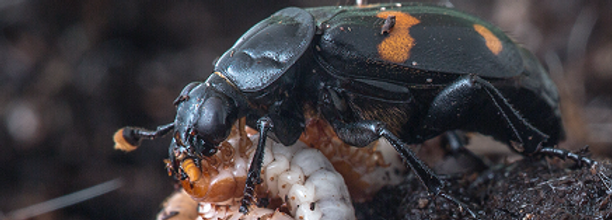

Evolution of Parental Care
(C) Jena Johnson
Parental care has evolved independently in every lineage of vertebrates and is of broad interest ecologically and behaviorally. Research in the Moss Lab aims to uncover the underlying mechanisms, decision rules, and patterns of plasticity that make parental care, in all its diverse forms, such a dependable strategy.
Previous Work

Figure 1: Gene expression profiles of female burying beetles sampled before and 24 hours after being introduced to larvae, at a benign (20*C) and harsh (24*C) temperature. Warmer colors represent high expression and cooler colors represent low expression.
Parental care evolves to buffer offspring against harsh and unpredictable environments and once evolved, can be instrumental for insuring offspring success across a range of conditions beyond those that promoted its evolution. In collaboration with Dr. Allen Moore at the University of Georgia, Jen's second postdoc investigated how flexible interactions among family members may help species persist through periods of environmental stress. Using a species of subsocial carrion beetle (Nicrophorus orbicollis) whose southern range limit extends into the southeast U.S., the team characterized plasticity of individual family members at the behavioral and molecular level across thermal conditions. Despite high fitness costs in terms of fecundity and offspring survivorship, neither male nor female parents significantly altered their allocation of care when faced
(C) Mikey Kartje
with thermal stress, although males spent less time feeding larvae when females were around regardless of temperature. How are females maintaining such energetically taxing behaviors? It appears that at the level of gene expression, thermally stressed females show a weaker response to larvae than counterparts in a benign environment (Fig. 1). Hence, stability at the behavioral level may be maintained by plasticity operating beneath the surface.
As an NSF postdoctoral fellow at the University of Illinois, Jen worked to address complementary questions in a monogamous and biparental poison frog, Ranitomeya imitator. A common thread in multi-parental systems is that it pays to reinforce reliability (the primary caregiver) with flexibility. But how do these negotiations between parents work? And more broadly, how does sex-biased plasticity shape the evolution of parental care systems? Working with Dr. Eva Fischer, Jen investigated how females integrate multimodal signals when 'deciding' to takeover for their absent male partners. A particular point of interest for the team is whether these frogs place higher value on acoustic signals than, for example, visual signals. In a recent collaboration with Dr. James Tumulty, they showed that the vocal repertoire of this species has expanded to accommodate contexts specific to biparental cooperation over

tadpole feeding. Given this specificity of male signals combined with female discriminatory abilities, co-evolution in female receivers in the context of other parental behaviors would seem likely. To truly understand the role that behavioral plasticity plays in evolution, however, more integrative approaches are needed to characterize and relate mechanisms operating at multiple levels of organization. Building from a conceptual framework developed in collaboration with Dr. Sarah Westrick, Jen's latest pub investigates the neurogenomic underpinnings of sex and individual variation in parental flexibility.
Next Steps
Future work in the Moss Lab will expand on the above investigations by applying integrative perspectives to study oft underappreciated, 'simple' forms of care. Despite its repeated origins, mechanistic studies of parental care continue to suffer from narrow taxonomic focus (i.e., highly derived forms of care in mammals), which tell us little about the potentially diverse routes to becoming a parent. Reptiles fill a crucial gap in this understanding as they provide windows into what care might have looked like in the ancestral amniote (i.e., most recent common ancestor of mammals and birds). To exploit this opportunity, our new lab at Virginia Tech will develop a lizard model - the five-lined skink (Plestiodon fasciatus) - to study how rudimentary forms of care seen in reptiles fit into the broader evolution of parenting

(C) A. & R. Simpson
across amniotes. This locally abundant species broods eggs until hatching and will readily express these behaviors in captivity, providing a rare opportunity to characterize the behavioral and neurological basis for care in these typically cryptic animals. We are also interested in leveraging comparative approaches to understand how egg attendance has diversified across squamates, from simple facultative to extended obligate forms, and whether adaptations for egg care might have been carried over to facilitate associations with live young.